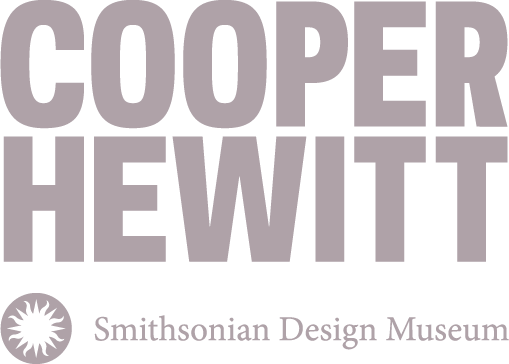Elyn Rosenthal
In the late nineteen-seventies, I was working in the fashion office at Macy’s Herald Square when my friend Marilise Flusser, the Fashion Director of Juniors at Saks Fifth Avenue, contacted me. She knew Willi was looking for a new assistant and made the introduction. She thought we would make a good team. I don’t remember much about our first meeting, but we had great chemistry, and we began our journey together. My background was in merchandising, textiles, and fashion events. From 1979 until 1981, I wrote the press releases, showed the collections to the press, assisted Willi with design and textile research, fashion show production, and traveled with him to India and Hong Kong.
I have vivid memories of our trips to India. The workroom in Mumbai where WilliWear was made was in a large factory. Mohammed was the head pattern maker who also ran the workroom and worked directly with Willi creating the samples from his sketches. They did not speak a common language but were able to communicate through signs and drawings. Although sometimes the ideas didn’t translate. One time, Willi requested two pairs of pants to be made, one in solid and one in plaid. The end result was one pair of solid pants lined with plaid print.
The factory didn’t have air conditioning, and my first trip to India was during the monsoon season. It was so humid in Bombay and at the factory. If you left scissors out overnight, when you returned the next day, they would be rusted. Willi had a large air-conditioned room built in the factory that we called “The Cabin.” In the cabin, there was a large worktable and a wall of mirrors. When we were creating a new design, Willi wanted to make sure that it worked for women of different heights, I was the short model, he was the tall model. We loved Velcro, and one season used it on a jumpsuit that you stepped into. The Velcro was on the straps and made getting in and out of it fast and simple—no buttons, no zippers—the problem was back then that people didn’t like the sound of the Velcro being pulled apart. We were early adapters in the fashion industry.
When we were in Mumbai, we always stayed in the old wing of the majestic Taj Mahal Hotel. The rooms were lovely, especially when they overlooked the Arabian Sea. Many of our local walks were to the antique shops where Willi had a sharp radar and always found the most interesting objects to add to his collections.There were several specialty shops in the hotel. One was the Nalanda Bookshop. They had a huge assortment of art books, the classics, local newspapers, many books in Hindi, and two-year-old dog-eared fashion magazines. What they didn’t have was many current international newspapers, and finding western news was hard to get.
While waiting for the fabric to be finished and the samples to be completed, Willi and I once traveled to New Delhi, visited the Taj Mahal, then traveled to Jaipur, Rajasthan. We stayed at the Rambagh Palace, which was being renovated at the time. It was a surreal experience as we were the only guests at the hotel. Willi had the guest room that had once been the bedroom of the Maharani with a bathroom that was as big as my apartment.
We also traveled to Hong Kong to work with the factories. It was not a direct flight, and we had a layover in Bangkok. We took a tour of the Floating Gardens and had to wait until the next day to fly out to because we missed our connecting flight. After we checked into a hotel, we spent the evening in the city. We went to dinner, and then a bar where women were in the boxing ring and men were cheering them on. It was quite bizarre. We must have been an original sight, a Black man with braids, an Indian man (Vijay Agarwal), and me, a young white woman. The next morning, we headed out to the airport to get to Hong Kong, still amazed by the city of Bangkok’s nightlife in the early nineteen-eighties.
I have vivid memories of our trips to India. The workroom in Mumbai where WilliWear was made was in a large factory. Mohammed was the head pattern maker who also ran the workroom and worked directly with Willi creating the samples from his sketches. They did not speak a common language but were able to communicate through signs and drawings. Although sometimes the ideas didn’t translate. One time, Willi requested two pairs of pants to be made, one in solid and one in plaid. The end result was one pair of solid pants lined with plaid print.
The factory didn’t have air conditioning, and my first trip to India was during the monsoon season. It was so humid in Bombay and at the factory. If you left scissors out overnight, when you returned the next day, they would be rusted. Willi had a large air-conditioned room built in the factory that we called “The Cabin.” In the cabin, there was a large worktable and a wall of mirrors. When we were creating a new design, Willi wanted to make sure that it worked for women of different heights, I was the short model, he was the tall model. We loved Velcro, and one season used it on a jumpsuit that you stepped into. The Velcro was on the straps and made getting in and out of it fast and simple—no buttons, no zippers—the problem was back then that people didn’t like the sound of the Velcro being pulled apart. We were early adapters in the fashion industry.
When we were in Mumbai, we always stayed in the old wing of the majestic Taj Mahal Hotel. The rooms were lovely, especially when they overlooked the Arabian Sea. Many of our local walks were to the antique shops where Willi had a sharp radar and always found the most interesting objects to add to his collections.There were several specialty shops in the hotel. One was the Nalanda Bookshop. They had a huge assortment of art books, the classics, local newspapers, many books in Hindi, and two-year-old dog-eared fashion magazines. What they didn’t have was many current international newspapers, and finding western news was hard to get.
While waiting for the fabric to be finished and the samples to be completed, Willi and I once traveled to New Delhi, visited the Taj Mahal, then traveled to Jaipur, Rajasthan. We stayed at the Rambagh Palace, which was being renovated at the time. It was a surreal experience as we were the only guests at the hotel. Willi had the guest room that had once been the bedroom of the Maharani with a bathroom that was as big as my apartment.
We also traveled to Hong Kong to work with the factories. It was not a direct flight, and we had a layover in Bangkok. We took a tour of the Floating Gardens and had to wait until the next day to fly out to because we missed our connecting flight. After we checked into a hotel, we spent the evening in the city. We went to dinner, and then a bar where women were in the boxing ring and men were cheering them on. It was quite bizarre. We must have been an original sight, a Black man with braids, an Indian man (Vijay Agarwal), and me, a young white woman. The next morning, we headed out to the airport to get to Hong Kong, still amazed by the city of Bangkok’s nightlife in the early nineteen-eighties.
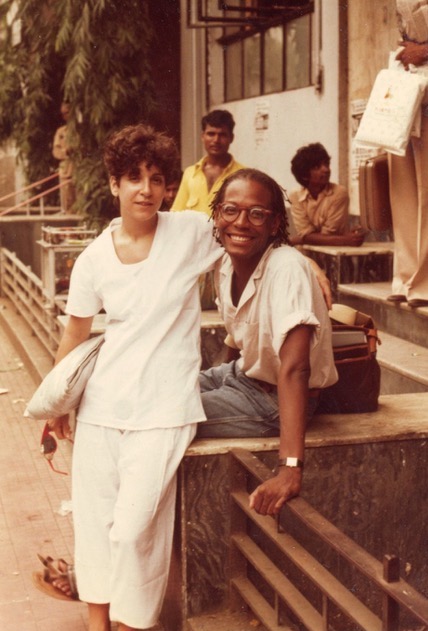
Elyn and Willi Smith in Mumbai, 1980
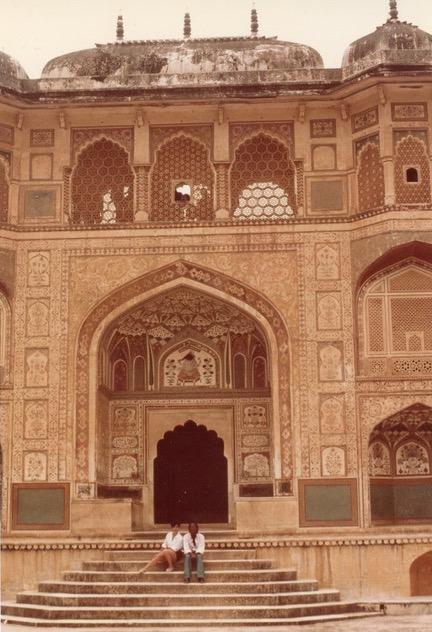
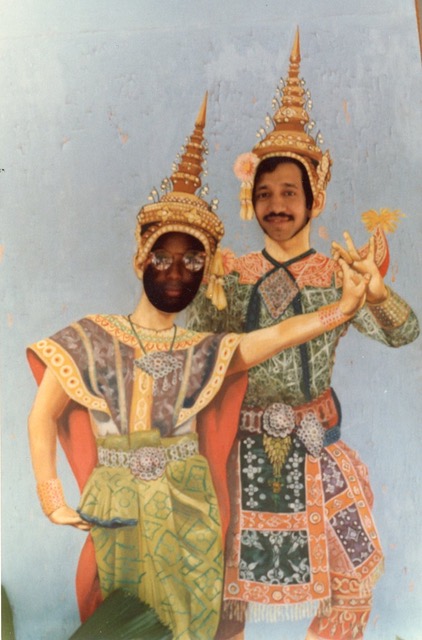
In Hong Kong, we stayed at the Peninsula Hotel along with other designers from all over the world who were there to check on their samples. It was a ‘Who’s Who’ in the American Fashion industry. It was the first time both Will and I were in Hong Kong. We shared many firsts on that trip. The Sony Walkman had just come out, and Willi bought one and walked through the Hong Kong airport singing Al Jarreau at the top of his lungs. That was a sight! One day at lunch, we ate a whole Peking duck. It was so rich, we went back to the hotel, skipped dinner, and didn’t leave our rooms until the next morning! We went to parties on the roofs of hotels and dinners with many of the New York fashion designers, including Willi’s good friend Norma Kamali. We also did work—visiting offices of our Hong Kong agent, looking over our samples, and visiting fabric mills to choose patterns for the upcoming season. There were always new inspirations from our travels—the colors, the shapes, the faces, the flowers, the noise, and so much more.
![]() Willi & Hong Kong agent staff, 1980–81
Willi & Hong Kong agent staff, 1980–81
![]() Elyn in WilliWear harem shorts and ticking bandeau top, 1980
Elyn in WilliWear harem shorts and ticking bandeau top, 1980
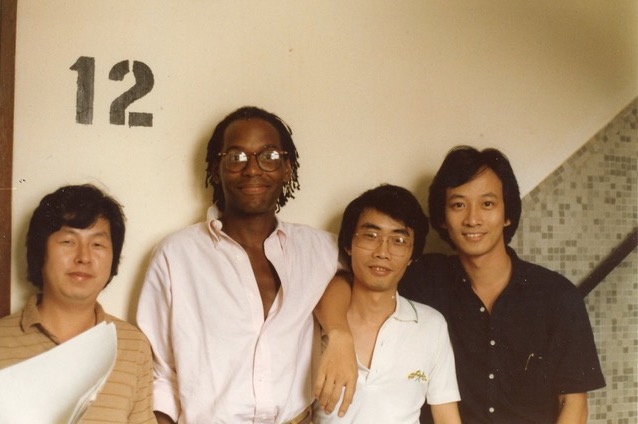
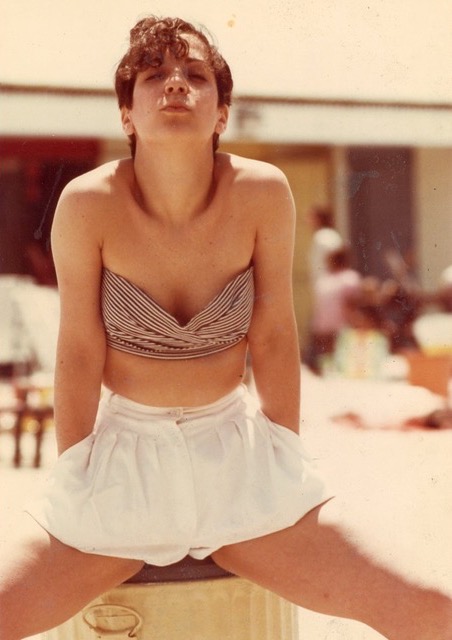 Elyn in WilliWear harem shorts and ticking bandeau top, 1980
Elyn in WilliWear harem shorts and ticking bandeau top, 1980
The New York studio and the showroom were located on separate floors in the same building on 39 Street. There were a handful of editors Willi would show the collection to, but first, I would warm them up before he came into the showroom. I remember Vera Wang, then fashion editor at Vogue, and Anna Wintour, then fashion editor at Savvy Magazine, but Willi was most excited when Bobbi Queen from Women’s Wear Daily came to see the collection! Willi’s friends would also stop in to visit, including artists, Christo and Jeanne-Claude, interior designers, Bob Patino and Vicente Wolf, models Bethann Hardison, and Norma Jean Darden.
Preparing for fashion shows was always filled with excitement and anxiety. The model castings in the New York workroom began with Willi showing the models the casual walk he was looking for. Often, it was hard to keep a straight face when a couture model showed up and could only walk like a flamingo! Sylvia Waters, the current director of the Ailey Legacy Residency, was a principal dancer at Alvin Ailey in the early eighties and a very close friend of Willi’s. Always wanting to create a new experience for the fashion editors and buyers, we came up with the idea of showing the collection at the Alvin Ailey Dance School and Dance Studio overlooking Times Square. Sylvia helped produce the show, which included the Ailey dancers as the models. It was a great success, but there was a scare after the show when the clothes went missing. They turned up in Alvin’s office, and after a little coaxing, we got the clothes back.
I remember one of the morning TV shows thought it would be a good idea to have a designer present a fashion show to the incarcerated women at Rikers Island Prison. At first, they chose Bill Blass but decided to have Willi present his collection as the women would relate to Willi’s casual style. A few of the inmates were our models, and when they came out there was a lot of excitement. The incarcerated women were delighted to see their friends on the stage, and at one point, it got a bit raucous. The women loved the show. When Helen Hayes, one of the inmates/models, was released, she began contacting Willi.
Working with Willi opened up my world, filled it with new adventures and an understanding and respect of other cultures.
![]()
Elyn in WilliWear poplin and terry cloth anarak jacket, 1980
Preparing for fashion shows was always filled with excitement and anxiety. The model castings in the New York workroom began with Willi showing the models the casual walk he was looking for. Often, it was hard to keep a straight face when a couture model showed up and could only walk like a flamingo! Sylvia Waters, the current director of the Ailey Legacy Residency, was a principal dancer at Alvin Ailey in the early eighties and a very close friend of Willi’s. Always wanting to create a new experience for the fashion editors and buyers, we came up with the idea of showing the collection at the Alvin Ailey Dance School and Dance Studio overlooking Times Square. Sylvia helped produce the show, which included the Ailey dancers as the models. It was a great success, but there was a scare after the show when the clothes went missing. They turned up in Alvin’s office, and after a little coaxing, we got the clothes back.
I remember one of the morning TV shows thought it would be a good idea to have a designer present a fashion show to the incarcerated women at Rikers Island Prison. At first, they chose Bill Blass but decided to have Willi present his collection as the women would relate to Willi’s casual style. A few of the inmates were our models, and when they came out there was a lot of excitement. The incarcerated women were delighted to see their friends on the stage, and at one point, it got a bit raucous. The women loved the show. When Helen Hayes, one of the inmates/models, was released, she began contacting Willi.
Working with Willi opened up my world, filled it with new adventures and an understanding and respect of other cultures.
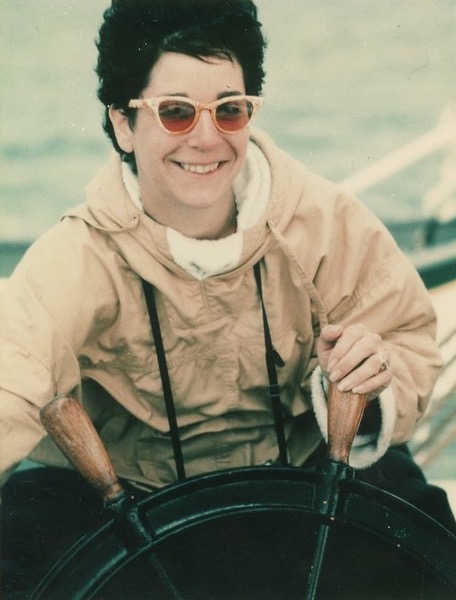
Elyn in WilliWear poplin and terry cloth anarak jacket, 1980
